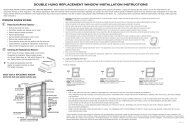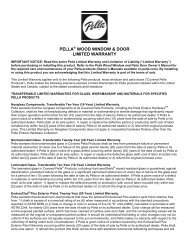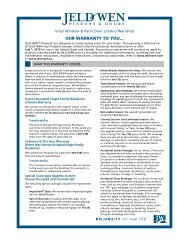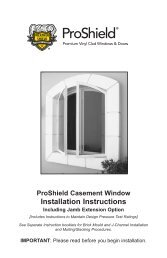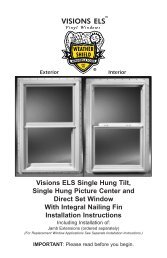Wood Hinged Patio Door - Weather Shield
Wood Hinged Patio Door - Weather Shield
Wood Hinged Patio Door - Weather Shield
- No tags were found...
Create successful ePaper yourself
Turn your PDF publications into a flip-book with our unique Google optimized e-Paper software.
FIGURE 1HRough Opening PreparationSAFETY INSTRUCTIONSRead installation instructions completelybefore beginning a procedure.CAUTIONWWear gloves, safety glasses, goggles, oreye shields appropriate to procedure.Before you begin, check the following:IMPORTANT:High-quality, exterior, neutral cure silicone caulkis to be used for all procedures in the followinginstructions which call for caulking.FIGURE 2IMPORTANT:Check to make sure you have the correctdoor type and the correct size door (Width andHeight) for your rough opening (FIGURE 1).1. Measure the rough opening to ensure that it is notmore than 3/4" wider in overall Width or 1/2" taller inoverall Height than the outside width or height ofyour entire door frame assembly (FIGURE 1).A2. Measure the rough opening diagonally fromcorner-to-corner in both directions. There should beno more than 1/2" difference between the twomeasurements (FIGURE 2 & 2A).FIGURE 33. Make sure walls are plumb and not twisted. Makenecessary corrections where possible to ensurewalls are plumb and straight (FIGURE 3).1
FIGURE 1Straighten & Level Sub-floor1. In masonry installations, <strong>Weather</strong> <strong>Shield</strong>recommends a wood sill plate the width of the doorsill, be present for anchoring the new unit’s sill.2. To straighten and level the sub-floor, countersinknails in the floor area that will be under the door(FIGURE 1).FIGURE 2!ATTENTION!BRICK MASON Provide a minimum clearance of1/2” from top of brick or masonry veneer to thebottom of the door unit. Failure to provideadequate clearance could result in sill bowing andimproper unit performance.WARNING! *Acid based cleaners used to cleanthe brick or masonry veneer may damage glass,fastener, window frame and hardware. Avoid thewindow unit when using a cleaner to preventdamage to the unit.WARNING!*Always follow chemical manufacturers’safety instructions when using chemicals, to avoidinjury or illness.BRICK MASON / SIDING CONTRACTORAll exterior finishes must have a minimum clearanceof 1/4” around the entire perimeter of the unit,except sill in masonry installations which requires aminimum of 1/2”.FIGURE 3Improper use of hand and power tools couldresult in personal injury and/or product damage.Follow equipment manufacturers’ instructions forsafe operation. Always wear safety glasses.2. Check for level as in (FIGURE 2). Plane areathat will be under the door until it is straight andlevel (FIGURE 3).2
Sill PreparationFIGURE 1ACUT &FOLDDOWN1"1. Cut a piece of weather barrier self-adhering tape(ice storm shield) 4" wide and as long as theopening width plus 8" (FIGURE 1). Apply to face ofexterior wall so 1” extends above the opening and 4"extends beyond each side of the opening. Cut alongthe corners of rough opening and fold down onto thesill (FIGURE 1A).Improper use of hand and power tools couldresult in personal injury and/or product damage.Follow equipment manufacturers’ instructions forsafe operation. Always wear safety glasses.FIGURE 22. Apply a second continuous piece of weatherbarrier self-adhering tape on the top surface of therough opening sill (FIGURE 2).Cut barrier tape the thickness of the wall and 12"longer than the width of the opening. Extend theedge of the tape 1" past the exterior wall surface(FIGURE 2B). Start the piece (approximately 6") upthe side of the rough opening and run it to thebottom of the opening, to the other side of theopening, and up 6" the other side (FIGURE 2).CUT &FOLDDOWNFIGURE 31"A1"BCAULK BEAD ONSUBFLOOR6"3. Use a utility knife to cut the sill piece on bothcorners of the rough opening, and fold 1" flap alongthe outside wall (FIGURE 2A).4. Apply a continuous 1/4" bead of high qualitycaulk (compatible with aluminum extrusion andexterior face of wall) to the exterior face of the walllocated 1/2" from the rough opening edge. Thecaulk bead must contact the nailing fincontinuously on sides and top when the unit isplaced into the opening (FIGURE 3).4. Apply a second bead of caulk on top of thesub-floor membrane 1/2" from the walls exteriorsurface (FIGURE 3).CAULK BEAD ONEXTERIOR OFROUGH OPENING3
FIGURE 1<strong>Door</strong> PreparationIMPORTANT:1A. Remove the metal handles, wood andcardboard used for shipping. Do Not remove theplastic shipping blocks or open the door.1B. High-quality, exterior, neutral cure, siliconecaulk is to be used for all procedures in thefollowing instructions which call for caulking.Improper use of hand and power tools couldresult in personal injury and/or product damage.Follow equipment manufacturers’ instructions forsafe operation. Always wear safety glasses.FIGURE 2Weight of window and door unit(s) and accessorieswill vary. Use a reasonable number of people withsufficient strength to lift, carry and install window ordoor unit(s) and accessories. Always consider siteconditions and use appropriate techniques wheninstalling.<strong>Door</strong> InstallationFIGURE 3ACBD1. Set the door in the rough opening (FIGURE 1).Center unit in the opening. Open the door andremove the plastic shipping blocks and woodshipping block at the sill. Close door and startinstallation.2. On the exterior, fasten unit by nailing fin in oneof the upper corners with a galvanized roofing naillong enough to penetrate the framing material by1-1/2" (FIGURE 2).3. Level unit on the interior or exterior across the silland head (FIGURE 3B).4. If necessary to level the unit, place shims directlyunderneath the side jambs only, see page 5“REVEAL” section.5. While holding the unit in place, square and plumbjambs. This can be done from the interior orexterior of the door. Check both side-to-side andinside-to-outside plumb. Measure unit fromcorner-to-corner to check square. To plumb, leveland square, use a pry bar to shift unit and shim asneeded (FIGURE 3A, 3B, 3C, 3D).6. Finish securing unit in opening by nailing throughall the pre-punched holes in the nailing fin makingsure the fasteners penetrate the framing material byat least 1-1/2".IMPORTANT: If unit is mulled itmust be supported with shims under each sillmull jamb for proper support.6a. If door is a wood brickmould unit, fasten with#10 galvanized casing nails; 6" from each cornerand every 12-16" between.4
RevealFIGURE 3SILLJAMBAHEADREVEAL1. To get the head level (FIGURE 3A), place a flatbar underneath the jamb, lift slightly, slide shimunderneath door (FIGURE 3). Check head for levelas in (FIGURE 3B page 4), adjust & add shim(s)until head is level.For Center <strong>Hinged</strong> <strong>Door</strong>s, place a shim under theastragal and adjust until the head jamb reveal isthe same from the side to the lock side of the door.FLATBARIMPORTANT:If unit is mulled it must be supported with shimsunder each sill mull jamb for proper support.SHIMFIGURE 1Fasten Sill1. Remove one of the center screws that arefastened through the threshold.2. Apply a generous amount of clear, siliconesealant into the screw hole.3. Refasten threshold with a 3" long (Inswing),3-1/2" long (Outswing) stainless flat head screw,provided by others. Drive it down into the sub-floorto anchor (FIGURE 1).For ADA sill: Follow Steps 1 & 2 above and thenuse (2) 1-1/2" long screws through the sill strikeplate. Drive them down into the sub-floor toanchor.IMPORTANT:Do not over pack insulation.Do not use expandable foam.Unit is ready for interior wall finish and trim.Note: Add exterior support block under the sill ifexterior aluminum sill is not supportedcompletely.Install the handle set according to themanufacturers’ instructions.4. Loosely insulate between the door frame andrough opening.5
Square and Straighten the InteriorFIGURE 1AB1. Straighten the side jambs by placing solid shimsbetween the rough opening and the side jamb ateach hinge. The gap (reveal) between the hingejamb and door must be exactly the same at allpoints along the height (FIGURE 2).FIGURE 2REVEAL2. Using a level as a straightedge, place shimsbetween the frame and the rough opening tostraighten other side jambs (FIGURE 1A & 1B).The gap (reveal) should be exactly the same at allpoints along the entire width and height of the door.Shim between the (2) lock holes and above & beloweach multi-point strike (standard option).FIGURE 33. Remove the top and bottom hinge screw, quantity(2) from each hinge, and replace with (2) 2-1/2"screws (provided), in order to anchor the door frameto the structural member in the rough opening(FIGURE 3).IMPORTANT:If the top or bottom hinge screw does not penetratethe framing material by at least 1-1/2", remove theside jamb weatherstripping and add (3) 2-1/2"screws to anchor the door frame to the structuralmember in the rough opening.Place at head, middle and bottom of jamb.FIGURE 4Head Strike PlateStandard: Install (2) - 2-1/2" long screws (supplied)nearest the weatherstripping, into the head jambstrike to anchor (FIGURE 4).INSTALLSCREWWEATHER-STRIPPINGTo maintain smooth operation of hinges, periodicallylubricate with silicone lubricant.6
Hinge Adjustment - RevealFIGURE 1FIGURE 2GUIDE HINGESIDEREVEALSET HINGE1A*Each insert will have three (3) guidehinges (FIGURE 1) to allow horizontaladjustment for side reveal (FIGURE 1A).*The other one (1) is a set hinge(FIGURE 2) to allow vertical adjustment forhead reveal) (FIGURE 2B) which will alwaysbe the second hinge down from the top.After the unit has been installed in theopening, the reveal around the head andsides of the door insert (and in between theactive and inactive inserts on 2-wide doors)needs to be equal for proper door operation.Hinge side gap will be approximately 1/16"to 1/8" and latch side gap will beapproximately 1/8" to 3/16".Use a Phillips head screwdriver to adjust thehinges.IMPORTANT:DO NOT use powered screwdrivers toadjust hinges.1. To adjust the guide hinge (horizontaladjustment) (FIGURE 1), turn theadjustment screw clockwise to make theinsert move towards the hinge side. Turnthe adjustment screw counter clockwise tomove the insert towards the latch side.Adjust each of the three guide hinges sothat the side reveal is equal (FIGURE 1A).2BHEADREVEALTo adjust the set hinge (vertical adjustment)(FIGURE 2), turn the adjustment screw inthe direction of the arrow shown on thehinge to make the insert move in thedirection of the arrow on the hinge.Note: Adjustment upward is easier if theweight of the insert is taken off the hinges.This can be done with blocks and/or a prybar under the insert to temporarily take theweight off the hinges (see page 5 “Reveal”section).Turn opposite of the arrow direction to makethe insert move in the opposite direction ofthe arrow. Adjust the height of the insert sothe reveal between the insert and headjamb is equal across the top. This will beapproximately 1/8". Check operation of thedoor to verify smooth operation of the door.Make minor adjustments if necessary byrepeating the above steps.7
<strong>Weather</strong> Barrier Self-Adhering Tape Application forUnits with Nailing FinsFIGURE 11. On the exterior, apply a high-quality weatherbarrier self-adhering tape or equivalent (ice stormshield). Apply to the sides, starting at the top of thehead nailing fin and run it down so that it extends6” past the bottom nailing fin. Tape must cover theentire nailing fin, including the installation holes andthe joint between the fin and the building’ssheathing. Use a rubber roller to apply (FIGURE 1).Improper use of hand and power tools couldresult in personal injury and/or product damage.Follow equipment manufacturers’ instructions forsafe operation. Always wear safety glasses.FIGURE 2WIDTH OF VERTICAL TAPETOP NAILING FIN2. Use a utility knife to cut a slit in the building wrapabove the head nailing fin, the entire length of thedoor unit PLUS the width of the vertical tape on thesides of the door (FIGURE 2).FIGURE 33. After cutting the slit above the top nailing fin,slide the high-quality weather barrier self-adheringtape or equivalent under the building paper makingsure the tape covers the nailing fin (FIGURE 3).8
FIGURE 1HEADSCREENCHANNEL1stScreen Installation1. If screen has been shipped separate from yourdoor unit, remove the screen from the packaging.2. Standing outside of the building hold screen withlatch handle toward operating side jamb and facinginterior. Grasp mid-way up on each side of thescreen. Insert top of screen into head screenchannel. Swing bottom of screen in until bottomrollers hit sill screen track (FIGURE 1).3. Lift wheels one at a time up onto sill screentrack. Roll the screen back and forth to see thatrollers are operating properly. Lifting wheels ontotrack is easier if you turn bottom adjustmentscrews counter-clockwise several times.2ndSILL SCREEN TRACKFIGURE 1Screen Adjust1. To adjust screen for smoother operation, insert aPhillips screwdriver into the screen adjustmenthole on the of the inside of the screen (FIGURE 1)and turn clockwise to extend the rollers and raisethe screen. Turn counter-clockwise to retract therollers and lower the screen. There is a set ofrollers at each corner, both top and bottom.Repeat the procedure with the top screen rollersif necessary.9
Screen KeeperFIGURE 1SCREENDOORSIDEJAMBSILLTRACK1. Open screen door approximately 12-18inches. On the screen door, flip the lockinglatch so it is in the up position.2. Place a tape measure on the sill track andmeasure up to the top of the silver lock tablocated on the side jamb of the screen door(FIGURE 1).Transfer that number to the inside side jamb(FIGURE 2).FIGURE 2FIGURE 32. Place the top of the keeper 1/8” below thetransfer mark on the side jamb (FIGURE 3).Fasten with screws (FIGURE 4).FIGURE 410
Recommended Finishing InstructionsAlways follow chemical manufacturers’ safety instructions when using chemicals to avoidinjury or illness.For Vinyl and Aluminum SurfacesVinyl and aluminum surfaces may be cleaned with mild soap and water. Hard to remove stains andmineral deposits may be removed with mineral spirits.• Do NOT clean with gasoline, diesel fuel, solvent based, or petroleum based products.• Do NOT use abrasive materials against vinyl, aluminum, or glass surfaces.• Do NOT scrape or use tools that might damage the surface.• Do NOT paint vinyl or aluminum surfaces.For Bare <strong>Wood</strong> Surfaces [See Next Page For Additional Information About <strong>Door</strong>s]For best results, wood should be sealed immediately upon installation or upon receipt, especially ifunit is being stored for ANY length of time.1. Remove all construction and adhesive label residue with mineral spirits before finishing.2. Lightly sand surfaces being finished with 180 grit or finer sandpaper. Be careful not to scratch theglass.3. After sanding, clean-off sanding dust using lacquer thinner applied to a cloth so the cloth isslightly damp. Let surface dry completely.-If a painted surface is desired:• If a wood unit is delivered with factory-applied primer paint, it may be painted withoutrepriming, providing the finish paint coat is applied within six (6) months of unit installation.• If a factory-primed wood unit requires repriming contact your customer servicerepresentative for help in selecting a primer compatible with the factory applied material.• Factory-applied Accentials TM color system finishes in standard, designer or custom colors do notrequire additional painting. For “touch up” paint specifications contact your customer servicerepresentative.1. An unprimed wood unit requires priming. Use only oil-based primer. Use compatible oil orwater-based finish coats. Refer to the primer and paint manufacturers’ instructions.2. When priming bare wood or repriming, cover all exposed wood surfaces. Priming all exposedsurfaces helps prevent end splitting, warping and/or checking.3. Once primed, apply two (2) coats of paint (again on all exposed sides) to each item.-If a stained surface is desired:If no sealer is applied over stain, the wood will weather very rapidlyand defects will occur. Apply at least two (2) coats of sealer.1. Use only oil-based stain. A gel stain is easier to apply as it does not easily run or drip. The cleartop coats may be oil or water-based. Apply at least two top coats of sealer or varnish.• A pre-stain wood conditioner, applied before staining, will help softer woods like pine absorb stainmore evenly. Apply both wood conditioner and desired stain according to the manufacturers’instructions.2. Apply one (1) coat of sealer to the stained surface and let dry. Using a spar (marine) varnish as asealer provides extra protection against sunlight and moisture. Let sealer dry completely.3. Before applying the next finish coat, make sure the previous coat is completely dry. Then lightlysand previous finish coat with 180 grit or finer sandpaper. Clean off all sanding dust and wipesurfaces with a tack cloth.4. Apply next coat of desired finish to surface and let dry. Apply only one coat at a time.5. For any additional coats of finish, repeat steps 3 and 4.-For a clear (natural) finish: Follow Steps 1, 2, and 3 under “Bare <strong>Wood</strong>” and Steps 2,3, 4, and 5 under “stained surface”.11
Recommended Finishing Instructions (cont.)<strong>Door</strong> InsertsAll active and removable door inserts, whethersliding or hinged, must be removed from thedoor frame after installation so they can beproperly sealed (FIGURE 1).Both clad and wood door units have bare woodon the top and bottom of the inserts. Paint orvarnish these areas as you would all of the otherexposed exterior wood. Follow proceduresoutlined in “Recommended FinishingInstructions” on previous page.Do not get paint, varnish, orsealer in the rollers on thebottom of sliding inserts. Rollers must bekept clean so they will rotate freely.Keep all sealers off weatherstripor bottom sweeps.FIGURE 1SEAL BARE WOODON TOP OF INSERT.SEAL BOTH STILES & RAIL.ACTIVE INSERTREMOVEACTIVE INSERTFROM FRAMESEAL BARE WOODON BOTTOM OF INSERT.SEAL BOTH STILES & RAIL.DO NOT GET SEALER IN ROLLERSOR ON WEATHER STRIP.12
<strong>Weather</strong> <strong>Shield</strong> Products With Synthetic StuccoSerious concerns have been raised about excessive moisture problems in homes and other buildings thathave Exterior Insulation Finish Systems, commonly referred to as EIFS or Synthetic Stucco.Many experts agree that a certain amount of water or moisture can be expected to enter almost anybuilding exterior system. The building system should allow such water and moisture to escape or “weep”to the exterior, so no damage occurs. However, some EIFS systems may not allow water or moisture thatpenetrates the wall system to “weep” to the exterior. This can cause excessive moisture to accumulatewithin the wall system, which can cause serious damage to wall and other building components. It hasbeen reported that so-called “barrier” EIFS systems are particularly prone to this problem.Moisture problems in any type of building structure can be reduced by proper design and construction withappropriate moisture control considerations, taking into account prevailing climate conditions. Examplesmoisture control considerations include flashing and/or sealing of all building exterior penetration points,use of appropriate materials and construction techniques, adherence to applicable building codes, andgeneral attention to proper design and workmanship of the entire building system, including allowancesfor management of moisture within the wall system.Determination of proper building design, components and construction, including moisture management,are the responsibility of the design architect, the contractors, and the manufacturer of the exterior wallfinish products. Questions and concerns about moisture management issues should be taken up withthese professionals. <strong>Weather</strong> <strong>Shield</strong> Mfg., Inc. is not responsible for problems or damages caused by deficienciesin building design, construction or maintenance, failure to install our products properly, or use ofour products in systems that do not allow for proper management of moisture within the wall system.Part No. 1029970/1029971/1182557 12/05 REV 4 Printed in U.S.A. © 2005 <strong>Weather</strong> <strong>Shield</strong> Mfg., Inc.



